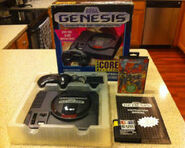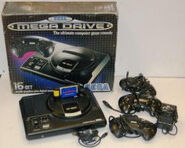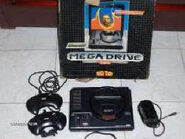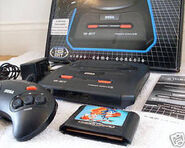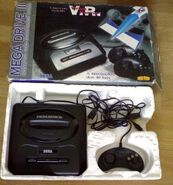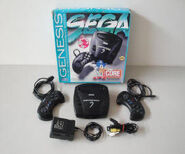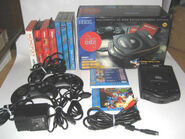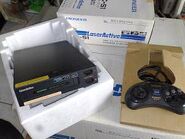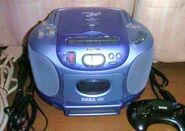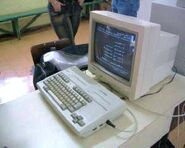The Sega Genesis, known as Mega Drive (Japanese: メガドライブ Hepburn: Mega Doraibu?) in most regions outside North America, is a 16-bit video game console which was developed and sold by Sega Enterprises, Ltd. It's home to some of the first console versions of Valis.
History
When Sega's arcade machines using System 16 technology become popular, Sega CEO Hayou Nakayama decided it was time to bring this technology into home video game consoles. Sega began developing their new 16-bit console based on System 16. Their final design worked out so well that they used the technology to make three new arcade boards (MegaTech, MegaPlay and System C). This now meant that any game made for these arcade machines could be almost perfectly ported to their new console. Sega also made their console backwards compatible with the Sega Master System with an add-on device later named the Power Base Converter.
The last issue was to give the console a name. The official name given to it in-house was MK-1601, but a more appealing name was needed when marketing to the public. "Mega Drive" was finally decided upon by Sega executives, "mega" being a word previously used by Sega when promoting games that were larger and more powerful than others, and "drive" being a word associated with speed and power. Sega of America could not use this name as it was already trademarked by another company. They went with "Genesis" instead, meaning "in the beginning", as Sega was leading the way in the beginning of the next-generation consoles.
To challenge Nintendo, Sega had everything it needed except for a mascot, a marketing campaign and a killer app. These three wishes were granted for Sega when they began accepting applications for mascots. The final decision was Sonic the Hedgehog. Not only would this become the "killer app" for the system, but Sega also now had the perfect mascot that emphasized the system's speed. Speed was the one thing that the Genesis excelled in and the SNES didn't. Sega's marketing campaigns were now all based around speed and aggressive advertising. Sonic even became the pack-in game with the console in place of Altered Beast. Sales skyrocketed.
1992-93 were Sega's best days. All their efforts and advertising had paid off. Great games were still being made and more and more third party companies were producing games for the console. The Mega CD/Sega CD had been released and so Sega were once again ahead of Nintendo technology-wise. Sega also released a Mega Drive II/Genesis II console that was smaller than the original and did not include a headphones jack or volume control. The Mega CD/Sega CD was also redesigned to fit with the new Mega Drive/Genesis, however, both versions of Mega CD/Sega CD will work on either console. It was in 1993 that Sega pulled ahead of Nintendo in the North American market share.
Things weren't so good by the end of 1994. Sega had not been advertising as much anymore. The Mega CD/Sega CD was not selling so well and Sega was now in debt because of it. The development and cost of producing the 32X also helped contribute to this debt. 32X was not selling well either. There were also disputes between Sega of Japan and Sega of America. All of this gave Sega a bad image to gamers and programmers. Not to mention the concern over violence in video games that had began the year before after the release of Mortal Kombat in which the Sega version was true to the arcade version, leaving all of the violence in, while the Nintendo version censored the really violent parts. Although Sega's version outsold Nintendo's 4 to 1, it was not giving Sega a good image.
In 1996, Sega announced it would drop support for the Genesis in favour of the Saturn, ending its manufacturing.
Hardware
The main microprocessor of the Genesis is a 16/32-bit Motorola 68000 CPU. The console also includes a Zilog Z80 sub-processor, which controls the sound hardware and provides backwards compatibility with the Master System. The system contains 72kB of RAM, as well as 64 kB of video RAM, and can display up to 64 colors at once from a palette of 512. The system's games are in ROM cartridge format and are inserted in the top.
The system produces sound by way of an FM synthesizer and a Texas Instruments SN76489 programmable sound generator, the latter of which is integrated with the VDP. The Z80 processor directly controls both sound chips, producing stereo music and sound effects, both synthesized and digitized. Most revisions of the original system contain a Yamaha YM2612 FM synthesis chip and a separate YM7101 VDP; these two chips were later integrated into a single custom chip for later versions of the console distributed worldwide.
The back of the model 1 console provides a radio frequency output port (designed for use with antenna and cable systems) and a specialized 8-pin DIN port, both of which provide video and audio output. Both of these outputs produce monophonic sound, while a headphone jack on the front of the console produces stereo sound. On the model 2, the DIN port, radio frequency output port, and headphone jack are replaced by a 9-pin mini-DIN port on the back for composite video, RGB and stereo sound, as well as the standard RF switch. Earlier model 1 consoles also have a 9-pin extension port, though this was removed in later production runs and is absent entirely in the model 2. An edge connector on the bottom-right of the console allows it to be connected to a peripheral.
Software
The Genesis library was initially modest, but eventually grew to contain games to appeal to all types of players. The initial pack-in title was Altered Beast, which was later replaced with Sonic the Hedgehog. Top sellers included Sonic the Hedgehog, its sequel Sonic the Hedgehog 2, and Aladdin. During development for the console, Sega of Japan focused on developing action games while Sega of America was tasked with developing sports games. A large part of the appeal of the Genesis library during the console's lifetime was the arcade-based experienced of its games, as well as more difficult entries such as Ecco the Dolphin, and sports games such as Joe Montana Football.
Gallery
Trivia
- Valis I and Valis III are both available for the Sega Genesis/Mega Drive, but Valis II was never developed for the console, an exclusive parody version, Valis SD, was developed for It instead.
- Sega Bought Renovation Products in 1992, making Genesis-exclusive all of the games It published, and cancelling many american translations for other consoles such as Psycho Dream.
- The Genesis (and the Sega-CD) was also home to many other ports (and some exclusives) of Telenet and Wolfteam such as Exile, Arcus Odissey, Arcus 1-2-3, Time Gal, Gaiares and Arrow Flash.

